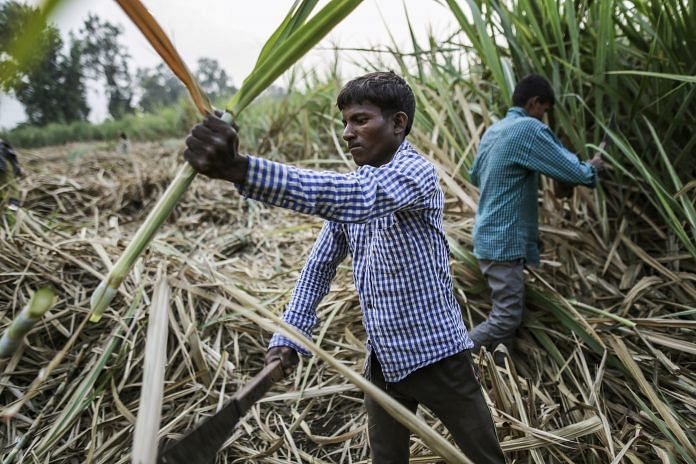Despite an overall rise, fresh crop loans disbursed in Vidarbha and Marathwada, two regions battling the deepest agrarian crisis, are still tepid.
Mumbai: After a massive shortfall in the Maharashtra government’s lending targets to the farm sector last fiscal, crop loan disbursements to farmers in the state rose by about 26 per cent in the first five months of this fiscal. But experts are being cautious in calling this an ‘uptick’.
Despite an overall rise, fresh crop loans disbursed in Vidarbha and Marathwada, two regions battling the deepest agrarian crisis, are still tepid. And the numbers are less than half of the targeted crop loan disbursements this kharif despite the launch of a loan waiver last year to get more farmers in the formal credit sector.
Also read: NHRC asks Centre & Maharashtra to explain 639 farmer suicides despite loan waiver
As per data from the state level banker’s committee, banks have met 44 per cent of their target for disbursement of crop loans during the kharif season of 2018-19 by 15 August.
In absolute terms, till 15 August banks disbursed crop loans worth Rs 19,178 crore to 25.59 lakh account holders against a target of Rs 43,874 crore for the kharif of 2018-19. This compares to a disbursement of crop loans worth Rs 15,117 crore during the same period last fiscal.
Overall, in 2017-18, the quantum of crop loans fell to Rs 25,322 crore, a 40 per cent drop as compared with Rs 42,173 crore in 2016-17. While banks had a target of ensuring a 29 per cent increase in crop loans this year, the actual disbursement was just 47 per cent of that target.
Government officials as well as bankers attributed this slump to the introduction of the farm loan waiver, saying a number of farmers were hoping to be eligible under the scheme, waiting for their loans to be waived. They said figures were likely to increase next year as the loan waiver gets more farmers back in the formal credit cycle. Banks do not extend fresh loans unless defaults are cleared.
Loan waiver implementation
“The purpose of the loan waiver was to ensure that institutional credit is made available to all farmers and crop loan disbursement is a 100 per cent,” Kishor Tiwari, farm activist and head of the Vasantrao Naik Sheti Swavlamban Mission, an organisation tasked by the state government to study the farm crisis in the state, told ThePrint.
“It was to ensure that farmers do not need to go to money lenders and are brought back in the cycle of formal credit. If the waiver was implemented properly last year, the crop loan disbursement would have been much higher today.”
Under immense pressure from farmer groups, the opposition as well as ally Shiv Sena, the Bharatiya Janata Party (BJP)-led state government rolled out a Rs 34,122-crore farm loan waiver in June last year. Farm activists and political parties have, however, criticised the implementation of the loan waiver citing unfair eligibility norms, a chaotic online system of applications, and red tape slowing down the process.
Ajit Navale, a Maharashtra State Kisan Sabha leader, said “The numbers are slightly better than last year, but they are not truly indicative of the crop loan coverage. The government finalises targets only looking at the number of eligible account holders. Those farmers who are defaulters and are out of the credit system are not considered while setting targets. So the number of targeted farmers is low, and within that if loans have been disbursed only to 41 per cent, it is an abysmal figure.”
Navale added, as per his estimates, in the Marathwada region alone, nearly 11 lakh farmers have not been able to get loans this kharif season.
Also read: PM Modi to travel across India to market his big MSP sop for farmers
‘Technical issues’
As per state data, in Marathwada, crop loan disbursements have been less than 30 per cent of the target. Banks disbursed crop loans amounting to Rs 3,606.22 crore to 6.27 lakh accounts till 15 August as against a target of Rs 12,093.05 crore. Similarly, in Vidarbha, banks disbursed crop loans worth Rs 4,355.32 crore, about 36 per cent of the targeted Rs 12,064.84 crore. The number of account holders who benefited from the loan waiver in Vidarbha is even lower at 5.90 lakh.
Experts also observed that the crop loan disbursement was much lower in comparison to the fact that 94 per cent of the kharif sowing has been completed so far.
A state government official who did not wish to be named said crop loan disbursements have been slow to pick up largely due to technical issues causing a delay in the implementation of the farm loan waiver.
He said, “There were a number of issues with the online applications, reconsideration of the criteria and so on that led to a delay in banks actually getting the money and waiving the loans of farmers. Meanwhile, it is also possible that farmers did not pay off their loans waiting to qualify for a waiver and could not be a part of the fresh credit cycle.”




Not meant to sound heartless, but one cannot have one’s cake and eat it too. One large farm loan waiver every five years, timed with an election, wrecks credit discipline, creates moral hazard. The banking system itself is going through an almost existential crisis, with credit growth at a fifty year low. If state governments want farm loan growth to be robust, a national consensus is required that there will be no more farm loan waivers. Between this and near free supply of power to agriculture, the banking and power sectors have been placed in great difficulty.